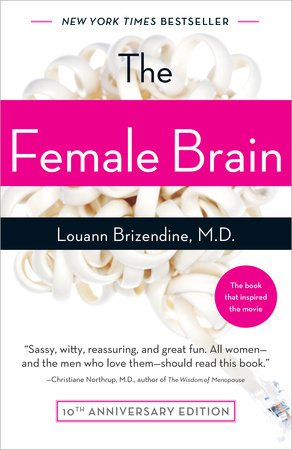The Female Brain Reader’s Guide
By Louann Brizendine, MD


1. Dr. Brizendine begins by describing the lack of clinical data on female neurology, psychology, and neurobiology she encountered as a medical student. How did years of emphasis on male subjects skew medical treatment for women and men alike? What did it take for physicians such as Dr. Brizendine to turn the tide?
2. Discuss the book’s discussion of gender and aggression in young children. What do these revelations, such as the fact that girls may inherently go through phases of bossiness as well as cooperatively taking turns, indicate about the way we should socialize children? Should our expectations of “acceptable” childhood behavior be altered in recognition of these innate patterns?
3. How does an understanding of the adolescent female brain ease or even alleviate your own memories of teenage angst? Which episodes seem less disconcerting when put in the context of physiology? Considering the way pleasure centers are stoked by gossip and sexual attractiveness takes priority, is it futile to try to tame the teen-girl brain?
4. What is the best way to reconcile the fact that most girls shun conflict while boys often enjoy it? What are the benefits and challenges of this contradiction? How do the adult manifestations of these features play out in the workplace?
5. Which aspects of Melissa and Rob’s case study regarding dating resonated the most with you? Can these findings be translated into a “prescription” for love? What lessons should single women take away from the observation that men are essentially chasers and women are choosers?
6. What surprised you in Dr. Brizendine’s chapter on sexual satisfaction? Did her distinctions between male and female orgasms differ from what you had previously believed? Does twenty-first-century dating accommodate these inherent gender differences?
7. What are the implications of the “mommy brain” for working mothers of newborns? Would it be beneficial or destructive if more fathers experienced the “daddy brain,” even extreme manifestations such as Couvade Syndrome? Do women inherently want to share the tasks of parenting?
8. Discuss the dangers and advantages of being able to read a man’s expressions with stealth and precision. If you were able to reduce your emotional attentiveness, would you do so?
9. With a better understanding of the inherently different communication styles possessed by men and women, can relationship woes be eased? Or is the communication gulf cause for despair?
10. Does American society embrace the wisdom of menopausal and post-menopausal women? Do contemporary grandmothers receive greater or less respect than in previous generations?
11. Based on the findings in Appendix One, how would you approach the controversial topic of hormone therapy? What is the best way to gain trustworthy advice on this subject from doctors?
12. What predictions can you make about shifting perceptions of gender wars in a culture that becomes more aware of neuroscience? How will the idealized and the fully realized woman be re-defined by our daughters?
13. How might the types of data revealed in Appendix Three shape future discussions about sexual orientation?
14. do the book’s extensive notes and references indicate about the nature of current research? Which fields appear to be the most progressive? What types of research needs are being addressed? What research question would you want to explore if you were to design a study regarding the female brain?
15. What is the effect of reading about personal, often emotional topics through the lens of science? What disputes in previous generations could have been resolved with our current scientific knowledge about gender differences?
16. Which stage currently matches your status in Dr. Brizendine’s chart, “Phases of a Female’s Life”? In what ways does the chart help explain your past behavior and predict your future responses?
Just for joining you’ll get personalized recommendations on your dashboard daily and features only for members.
Find Out More Join Now Sign In